Daring action of Polish fighters from the legendary Skalski Circus. Polish pilots knock down 6 enemy machines without losses of their own. Thanks to this, the British completely destroy the expedition of the great Luftwaffe transporters. The fate of the Afrikakorps "Desert Fox" is sealed.
In April 1943, the defeat of the Axis forces in North Africa was already a foregone conclusion. The German-Italian forces, encircled in Tunisia, were practically cut off from supplies. It was also difficult for them to make up for losses in equipment and soldiers. Allied planes and ships drowned enemy ships one by one.
The only hope was aviation. Within two months, Luftwaffe transport squadrons transferred about 21,000 to Africa at the cost of enormous losses. soldiers and weapons, ammunition and fuel.
The shortest route was between Sicily and Cape Bon (Cape Bon) in Tunisia. The planes covered the distance of almost 140 km in about half an hour. Flights were carried out early in the morning, usually at low altitudes, to avoid detection by British radars. This area quickly became the focus of attention from the Allied fighters.
The glorious fifteen arrives
The Polish Hunting Team, popularly known as "Skalski's Circus", was stationed in North Africa from the beginning of March 1943. It was a select unit consisting of only volunteers, one of the best fighters in the Polish Air Force. The commander was appointed Cpt. Stanisław Skalski.
Among the pilots there were hunting aces such as Lieutenant Eugeniusz Horbaczewski or Capt. Wacław Król. In total, the Polish squadron consisted of 15 pilots and a liaison officer. The Poles were part of the 145 Squadron of the RAF, belonging to the 244th Fighter Wing.
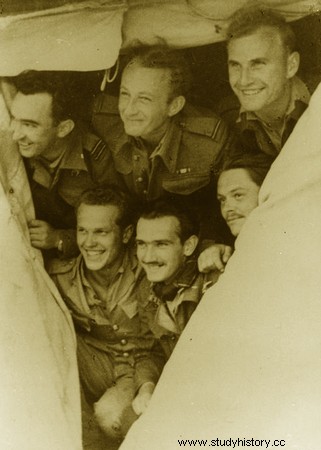
Pilots of the Polish Hunting Team. First from the left, Capt. Wacław Król. Photo taken in North Africa.
From April 13, Polish fighters were stationed at the Goubrine field airfield in northern Tunisia. The squadron was equipped with Spitfire Mk IX planes, the most modern fighters in the Western Desert at the time.
It was supposed to be a routine patrol
On April 22, 1943, around 6 a.m., six Polish fighters from the Skalski Circus set out on a patrol over the Strait of Sicily. They were commanded by Lieutenant Karol Pniak. The other pilots were:Lieutenant Eugeniusz Horbaczewski, Lieutenant Kazimierz Sporny, Second Lieutenant Jan Kowalski, Senior Sgt. Marcin Machowiak and Senior Sgt. Kazimierz Sztramko.
In addition, the formation included three more squadrons from the 244th Wing. It was a total of 30 spitfires. The British piloted the older versions of the Mk V.
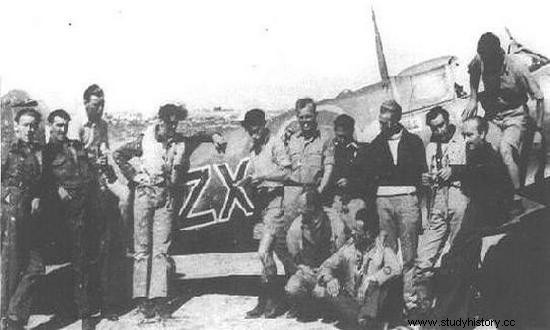
Six pilots of the Polish Hunting Team took part in the action of April 22:Karol Pniak (third from the left), Eugeniusz Horbaczewski (fourth from the left), Kazimierz Sporny (first from the left), Jan Kowalski (second from the right), Marcin Machowiak (seventh from the left). left) and Kazimierz Sztramko (eighth from the left).
Allied fighters formed an array over Goubrine Airfield and headed towards Cape Bon. Individual squadrons were at different heights, from one and a half to four and a half thousand meters. Polish spitfires flew highest. In the event of an unexpected enemy attack they were supposed to cover the other fighters and take the momentum of the first strike.
In the crosshair of Messerschmitty
After less than 20 minutes of flight, when the fighters had passed Cape Bon, electrifying information came from the RAF ground command post. The controller reported the detection of about 60 enemy planes over the middle of the Sicilian Channel, on a low-altitude course for Tunis. The Spitfires rocked uneasily at the news. The pilots scanned the sky carefully in search of the enemy.
Attention guys! They're flying, damn it, on the right. he communicated to his pilots Lieutenant Pniak. Indeed, after a short while, huge six-engine transports appeared at low altitude. They flew in several groups of 5 machines, there were almost 30 of them in total.
These were the Messerschmitts Me 323 "Gigant", the largest transport aircraft of World War II. Machines heavily armed, even with a dozen cannons and machine guns , relatively resistant to fire, but slow, reached only 225 km / h. They could transport 120 soldiers or up to 10 tons of cargo, including trucks and light tanks.
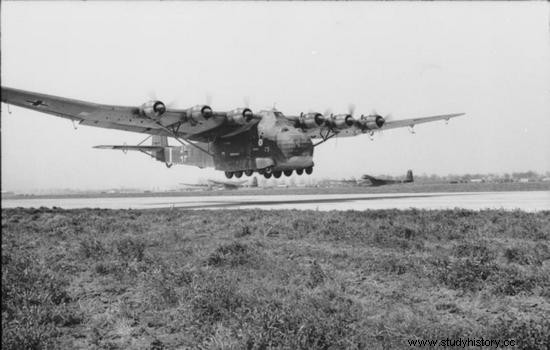
Messerschmitts Me 323 "Giant" in all its glory. Its size is really impressive. Suffice it to mention that the wingspan was over 55 meters! (source:Bundesarchiv; lic. CC BY-SA 3.0).
There was an incredible opportunity to destroy an enemy almost defenseless against fast and maneuverable fighters. However, Polish pilots were careful. Such a large group of transporters could not fly without an escort. Lt. Pniak was the first to spot enemy fighters again.
About 30 enemy fighters were flying high above the "giants". The temptation to attack the German transporters had to be resisted. It could have ended badly for the British thus deprived of their cover.
We're taking them on!
Lieutenant Pniak made an immediate decision. He made radio contact with one of the British commanders and led his six on the fighter jets of the German escort. British squadrons were to take care of the Me 323.
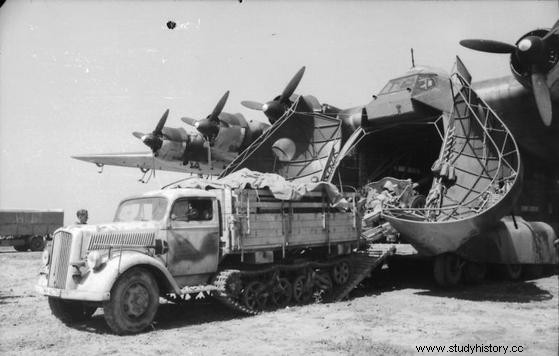
The Messerschmitt Me 323 "Gigant" could easily transport guns, trucks and even light tanks. That is why it was so important to eliminate these machines from combat (source:Bundesarchiv; lic. CC BY-SA 3.0).
Polish spitfires climbed up in no time. They had to take a convenient position and attack the enemy from the sun. The surprise was complete.
Already in the first attempt two Messerschmitts Bf 109 and one Italian macchi Mc.202 "Folgore" went down. Their pilots jumped out on parachutes. The winners were Sporny, Horbaczewski and Sztramko. The other colleagues secured them so that the enemy fighters would not get to their tail
In the meantime, enemy planes have formed a defensive circle. The same winning three Poles gained height again and struck again. The enemy fighters could not withstand the blows and their formation disintegrated. There were individual air duels.
Well, one more line, gentlemen
Lieutenant Kazimierz Sporny shot down another Bf 109 after his second turn. As he emotionally shouted to his friends after returning to the base:
Two, Mr. Antoś, I got two. They stood under the barrels, Mr. Antoś. One jumped out with a parachute right away when I warmed it up, and the other a little later. If the third one had collapsed, I would have blasted it too, because my ammunition was damn. But heca, Mr. Antoś!
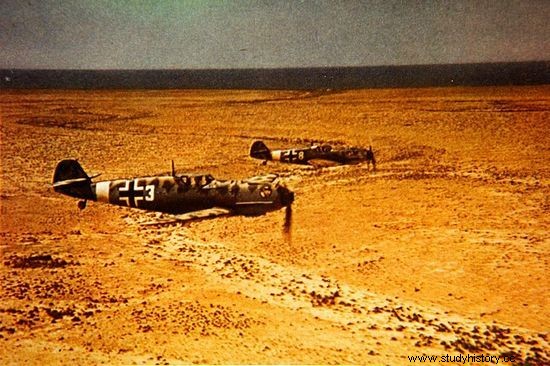
German Bf 109 fighters from Jagdgeschwader 27 Afrika. It is, among others Our fighters fought with the pilots of this unit on April 22 (source:wikimedia commons, public domain).
Small and short, but very aggressive Lieutenant Horbaczewski also caught up with another Messerschmitt Bf 109. He sat on the German's tail and from a short distance ran towards him in short bursts until he caught fire. The enemy pilot then turned his machine and jumped out with a parachute.
The most fierce duel was probably fought by Senior Sgt. Kazimierz Sztramko . He fought a Bf 109. Both machines flew head to head at each other. They were approaching each other at great speed, firing all barrels. Finally, when it seemed that a collision would occur, the German pilot could not stand it and pulled his plane up. Above Sztramka's head, the Messerschmitt burst into fire and another German pilot had to save himself by parachuting.
Great victory for the Allied fighters
Meanwhile, the remaining three pilots of the Polish squadron headed for the second group of enemy fighters. These did not accept the fight and dove towards the transports. One of the British squadrons blocked their way. The rest were busy "processing" transport "giants".
There was a slaughter of German transporters. One by one they crashed into the waves of the Mediterranean Sea. Some, possibly carrying fuel, burned like torches. Crew members jumped out, often in burning uniforms, some without parachutes. Many soldiers in life jackets have also been observed on the sea surface.
The victory of the Allied pilots was complete. All German transporters were shot down. The surviving German and Italian fighters retreated from the battlefield. The German army in Africa did not receive any reinforcements.
Bibliography
- Bohdan Arct, Alarm at St. Omer , Zysk i S-ka, Poznań 2010.
- Same, Heaven on fire , Zysk i S-ka, Poznań 2009.
- Bernard Ireland; War in the Mediterranean Sea , Bellona Publishing House, Warsaw 2006.
- Wacław Król, My Spitfire WX-L , MON Publishing House 1975.
- Same, I fought under the skies of Europe and Africa , Ludowa Spółdzielnia Wydawnicza, Warsaw 1991.
- Aviation Encyclopedia. Technique, types, data, DEBIT Publishing House, Bielsko-Biała 1998.
